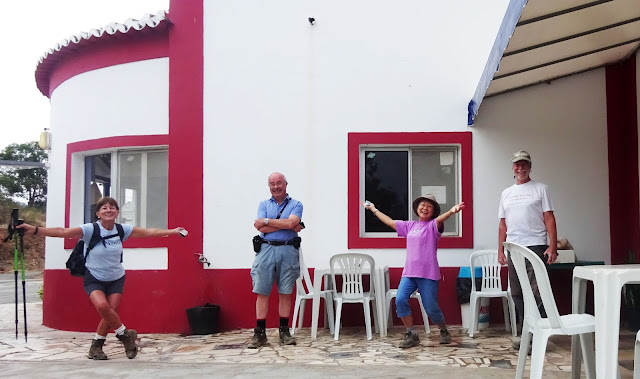This week´s Blog starts with a P.S., a Post Scriptum to last week´s blog because Yves´ would-be comment included a photo, which the Blogger Comments box does not cater for. And if any of the current readership are offended by the appearance of yet another cricketing picture, when I had promised no more on that topic, I can only apologise by saying that Algoz takes precedence, alphabetically at least, over Belgium and by echoing Shakespeare´s words:-
“If we cricket fans have offended,
Think but this, and all is mended, -
That you have but slumber´d here,
While these visions did appear.
And this weak and idle theme,
No more yielding but a dream.”
And now to Yves´comment:- if you remember, I had queried his particular interest in the Belgian Ladies cricket eleven.
Quote
Prof Ferrer, aka Aris-total on occasions, here!
May I point out that my interest in ladies’ cricket is purely due to strict compliance with my duties of ‘Custodian of Sporting Traditions Here and Elsewhere’?
It falls to me, therefore, to ask whether said ladies did or still do observe the time-honoured friendly gesture of exchanging jerseys at the end of the match: photographic evidence is always a help in such circumstances as one cannot be in more than three separate locations at any one time… Can anyone in possession of such pictorial record help out? Please?
For the sake of cricket reporting world-wide, I enclose a photograph of Algoz First XI batting away at wicked deliveries from Tunes Cobbled XI.
Connoisseurs will enjoy the finer details of pitch condition, improvised stumps and the relative positions of the (tennis) ball and the bat… Moi, I was just the snapper, your ’onor!
Yves
.PS: I would have included the above as a comment to your wonderful essay but Phat Phingers and Thick Thskull prevented it… Perhaps you might fit it in? Thanks!
unquote
And now, having got that out of the way, we can move onto the Walk. The day before, it looked like numbers walking, as opposed to just eating, were going to be on the up, with as many as seven signing on . However,that evening Terry and Jill had to call off because the former had caught a bit too much sun – better not to risk it. So there were five Starters, including Myriam who, having lost her bearings the previous time at Pescadores, made sure that she was there first this time, her dead-reckoning functioning perfectly.
The Starters
The early morning stroll along the canal in the early morning sunlight was delightful, apart from a great chorus of barking dogs.
But that din soon ceased and as we moved into the woods there was only the chatter of the ladies to be heard as they went along ahead at a considerable pace, oblivious of whether they were on the correct track or not.
Some strange ornithological observations were made.
Soon, however, a new noise became more and more persistent – the sound of chain saws and of falling trees. Some large scale logging was taking place as the eucalyptus crop was being harvested.
Whole hillside were being stripped, with the likelihood that, for the next two or three years there will be little shade on these familiar tracks. Another side effect is that the heavy equipment being used to transport the logs has churned the tracks up so much that, as we had noticed at Aguas Belas the previous week, there is thick powdery earth everywhere, several inches deep.
Now, this stuff may be soft to walk on but don´t be deceived. The dust is treacherous because one cannot see what stones and rocks are hidden underneath. And this may be what caused Jim to stumble and fall like a ninepin face first into the dust.
This was the chance for Dr Ferrer to put the skills he acquired during his service with Médecins Sans Frontières into practice. Ably assisted by Maria, he quickly staunched the blood flow and applied ointment to Jim´s grazes. Then Colonel Ferrer´s mountain rescue experience, gained from his training with 15 Peloton de Gendarmerie de Haute Montaigne, kicked in as he guided a somewhat shaken Jim down the rocky tracks in the direction of home base. Suffice to say, they all got back in good time for breakfast.
Non-walkers, Chris, Antje, Paul and Hazel were there for the meal and Rod put in his usual avuncular appearance in time for for coffee. Breakfast was the usual high Pescadores standard, with Hazel and Maria providing much appreciated assistance.
Contact was made by phone with Terry who sounded cheerful enough and Myriam entertained us with anecdotes about Chinese singing birds and crickets (insects, not the game). Paul updated us with the latest news from his aviary of finches.
Pescadores provided us with figs fresh from their horta and Sensei Yves demonstrated his familiarity with the art of fruit and vegetable carving (Mukimono in Japanese or Thaeng yuak in Thai).
It is rumoured that he intends to take part in the IKA/Culinary Olympics Fruit and Vegetable Carving Competition. Yes, there really is such a thing. Watch this space.
Is there no end to the man´s many talents?
Well, yes actually; he has not yet mastered how to Blog. Now there´s a challenge.
The Track and Statistics
Any suggestions for a sport that the APAPS/WAGS might support or supplement their meagre pensions by indulging? Caracois racing perhaps!






























































